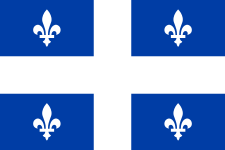蒙特利尔和魁北克的空气质量数据已经提供了一段时间,但我们最近收到了一些关于加拿大该地区使用的 AQI 等级的问题。其中一封来自 Marie A.,她问道:
我想知道为什么你们网站上的空气质量指数与蒙特利尔网站上的AQI不一样?您是否重新计算任何内容以满足 US EPA AQI 标准?如果是这样,怎么办?用什么数据?
例如,日期为 7 月 14 日下午 2:00,您网站上的大多数指数范围为 53 到 65(其中一个指数为 37),并且应该是实时 AQI。蒙特利尔市网站上,日期为7月14日下午2点,大部分指数范围为16至37,也是实时AQI。
那么,您能解释一下区别以及您使用的标准细节吗?
这确实是一个非常好的问题。我们将在本文中解释所使用的不同比例、这些比例如何相互比较以及如何进行转换。
oOo
正如我们在之前的一篇文章中所解释的,世界空气质量指数项目中发布的所有 AQI 数据目前[1]使用美国 EPA 标准。蒙特利尔和魁北克都没有遵守此规则,因此这证实了城市/蒙特利尔页面上显示的值正在使用美国 EPA 标准。
这就是世界空气质量指数项目读数与蒙特利尔市网站 ( montreal.qc.ca ) 之间存在差异的原因:蒙特利尔市 EPA(环境保护局)正在使用自己适当的 AQI 等级,该等级在同一个网站。为了使其稍微“复杂”一些,与蒙特利尔(塔巴纳克!)相比,魁北克实际上使用了另一种 AQI 量表(在此链接中指定)。当然,加拿大正在使用另一种量表,称为空气质量健康指数 AQHI - 但这是我们在另一篇文章中已经写过的内容。
下表列出了蒙特利尔和魁北克省 AQI 断点汇总:
| Pollutant | Quebec | Montreal | ||
|---|---|---|---|---|
| Averaging Period | Reference Value | Averaging Period | Reference Value | |
| Fine Particles (PM2.5) | 3 hours | 35µg/m3 | 3 hours | 35µg/m3 |
| Ozone (O3) | 1 hour | 82 ppb | 1 hour | 160 µg/m3 |
| Nitrogen dioxide (NO2) | 1 hour | 213 ppb | 1 hour | 400 µg/m3 |
| Sulfur dioxide (SO2) | 4 minutes mobile | 213 ppb | 10 minutes mobile | 500 µg/m3 |
| Carbon monoxide (CO) | 1 hour | 30 ppm | 1 hour | 35 µg/m3 |
oOo
为了将这些值转换为美国 EPA 标准,需要以毫克或ppb/ppm (每十亿/百万颗粒数)表示的原始浓度。
不幸的是,蒙特利尔和魁北克县都没有提供这些原始浓度。相反,他们仅提供已转换为各自 AQI 等级的空气质量读数。但这实际上不是问题,因为可以使用这个简单的线性公式来重新转换为浓度:
Raw concentration (pollutant) = Reference value (pollutant) * AQI }(pollutant) / 50例如,如果蒙特利尔市网站上发布的 PM 2.5 AQI 值为 18,则原始浓度(以毫克为单位)为 18*35/50 = 12.6 mg/m3。请注意,对于臭氧、CO、SO 2和 NO 2 ,魁北克和蒙特利尔的单位有所不同(魁北克为 ppb - 美国标准,蒙特利尔欧盟标准为 mg),但这只是额外的转换(本文部分解释) 。
请注意,PM 2.5 AQI 基于 3 小时平均值,而在世界空气质量指数项目中,使用每小时PM 2.5 Instant Cast AQI 报告。由于无法从 3 小时平均值中扣除每小时数据,这实际上意味着蒙特利尔和魁北克世界空气质量指数项目报告的 PM 2.5 AQI 并不完全是“即时广播”报告。
oOo
最后,这是 PM 2.5和臭氧的 3 个 AQI 等级(美国 EPA、魁北克和蒙特利尔)的视觉比较(请注意,对于臭氧,使用 ppm 单位 - 因此蒙特利尔的毫克到 ppm 的转换) 。
值得注意的一点是,魁北克省和蒙特利尔都使用 AQI 值 25 作为良好(绿色)和可接受(黄色)之间的断点,而美国 EPA 的断点设置为 50。因此,总而言之,在考虑正确的转换和断点的情况下对苹果进行比较时,美国 EPA 标准和魁北克/蒙特利尔标准报告的 AQI 范围非常相似。
--

